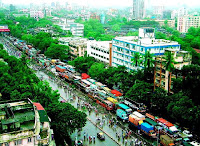
I remember long ago, when I was a kid, every time it rained, I would walk down the wet streets, without an umbrella, soaking in the rains and enjoying the sweet smell of the earth. Sometimes I would invite my friends to join me in the building compound and happily splashed the puddles. We didn’t care about getting wet or dirty, because it gave us great pleasures in getting wet and enjoying the warm showers. But everything has changed after the out burst of killer rain. The sounds of even the mild showers frighten the child of today. Every time it rains, the children run to seek a safe place where they can hide. They stay there cuddled till it is dry and bright again.
Nothing is close to what Mumbai experienced during those two days. Mumbai, strung together from seven islands, found itself marooned on Tuesday, July 26, 2005. The incessant rains recorded at 896mm in 24 hours (first ever in 100 years) were more anybody could imagine. The streets looked like rivers, people were stuck at workplaces overnight, powers were cut off in many places, phone lines were not working, interconnectivity with the outside world was on the halt as flights and trains were suspended. Even as close to thousands lay dead, millions could barely keep their body and bone together. The state government declared public holiday for two days, as the commercial capital bobbed up like flotsam, facing the fury of the dark skies.
People were struck for many hours in the city’s life stopping floods, with barely enough water to moisten their lips. It was virtually like one of those, water-water everywhere (not a drop to drink) situation. Many people just abandoned their vehicles and waded through the knee-deep water to reach a safe place. Those who stayed were trapped inside their cars and many of them lost their life when it was too late to escape from jammed-up car doors. Thousand of students spent their nights in the classrooms. Hundreds were marooned in their buildings, those in Kaline-Kurla airport colonies required water rafts and army to help reach safety. The electric poles collapse and sent the electric currents through water and many people were electrocuted. Animal and human dead bodies floated in the water for hours. For those two days, only personal records mattered. Dreams of international Shanghai-like city found a quiet, wet burial.
Mumbaikars added new survival skills to their enviable repertoire. People of every neighborhood served tea and biscuits to all the stranded and disoriented commuters. Residents opened their doors to commuters who couldn’t proceed further. Those made people regain their faith in the city.
People in the slums suffered the most. All the appliances, utensils and furniture floated in their tiny rooms. Women and children sat perched on the rooftops, hungry and thirsty, completely drenched in dirty and filthy water, patiently waiting for the rains to stop and water to recede.
The airports remained closed for two consecutive days. Crucial navigation and landing aids such as the instruments landing system and distances measuring instruments were not available, forcing diversions of all international and domestic flights. Thousands of tourists were stranded at the airports.
Mumbai’s floods were a result of the large-scale urbanization with little care for nature. Concrete jungle erupted as eyesores all over Mumbai and along the river Mithi and mangroves simply gave way to building without any heed being paid to environment. These mangroves acted as natural barriers to the sea and in absence of the same, the high tide combined with the cloud bust resulting in the flooding of the city that caused widespread loss of human life and property. The drains simply did not function due to having been choked with plastic, and the only solution to the choking of the drains seems to be was to ban plastic once and for all.
Floods continued to interrupt the post flood relief work in Mumbai. While all people whether rich or poor, have been hit badly, the worse affected are those on the threshold of survival whose capacity to take any more shocks is very little. As the city limps back to normalcy, the scars are still there. Although Mumbaikars suffered a lot during those days, they have to be applauded for their resilience, fortitude, courage and patience in dealing with this calamity!
No comments:
Post a Comment